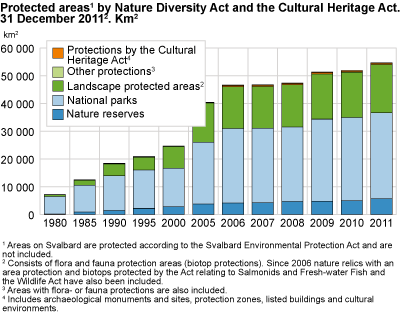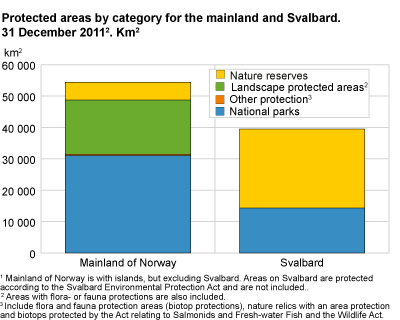Content
Published:
This is an archived release.
Two new national parks
In 2011, 2 national parks 2 , 38 nature reserves, 7 landscape protected areas, 8 842 archaeological monuments, 121 listed buildings and 4 security zones were protected. This was broken down into 8 600 on the mainland 1 and 360 on Svalbard.
The total number of protected areas in Norway are approximately 97 0003 covering more than 94 100 km 2 of the land area - equivalent to 25 per cent. Protected areas on the mainland made up 17 per cent and on Svalbard as much as 65 per cent of the land area. In Norway, the national parks combined account for the largest part of the protected areas. The national park areas are more than 45 400 km 2 , divided into about 31 000 km 2 on the mainland and 14 400 km 2 on Svalbard. Norway has a total of 41 national parks, 34 of which are located on the mainland and 7 on Svalbard.
The national parks Langsua and Rohkunborri
The smallest national park in Norway was until recently Ormtjernkampen, at less than 9 km 2 , but in 2011 this was incorporated into the new and somewhat larger national park Langsua in Oppland. Also Rohkunborri national park (571 km 2 ) in Troms got established in 2011.
In 2011, the national parks made up 57 per cent of the conservation land area on the mainland, and have increased by approximately 1 000 km 2 (2 percentage points) during the year. The largest national park on the mainland is Hardangervidda, with an area of about 3 445 km 2 . With regard to counties, Nordland and Oppland have the largest national park areas, with approximately 5 000 km 2 each. Not all counties have national parks. Only one of the national parks includes area of skerries, and areas of fjords are very limited. It is on Svalbard we find Norway’s largest national park; South Spitsbergen, with an area of 4 957 km 2 . However, the national parks on Svalbard only account for 36 per cent of the total conservation area.
Nature reserve area is the most important category of conservation on Svalbard
The most frequently occurring category of conservation form is nature reserve on Svalbard, which also forms the largest conservation area (41 per cent of the group of islands). The group of islands has a total of 25 200 km 2 of nature reserves; approximately the same area as the national parks on the mainland. The largest nature reserve on Svalbard is Bjørnøya, at 177 km 2 . The smallest nature reserve is the bird sanctuary Guissezholmen, which is less than 1 km 2 . There are 21 nature reserves on Svalbard, but more than 2 000 on the mainland. There were 38 new conservations of nature reserves on the mainland in 2011, however these cover very little area compared to the extension of the nature reserve area on Svalbard.
Landscape protected areas have increased in size
During 2011, landscape protected areas increased in total by more than 1 000 km 2 on the mainland. Landscape protected areas, with 17 300 km 2 , make up an important part of the total area of conservation areas on the mainland (32 per cent). Møre og Romsdal has clearly the largest area, with more than 2 500 km 2 . All the counties have landscape protected areas, however Svalbard has no landscape protected areas.
| Mainland 1 | Svalbard | The Kingdom of Norway 2 | |||||||||||||||||||||||||||||||||||||||||||||||||||||||||||||||||||||||||||||
|---|---|---|---|---|---|---|---|---|---|---|---|---|---|---|---|---|---|---|---|---|---|---|---|---|---|---|---|---|---|---|---|---|---|---|---|---|---|---|---|---|---|---|---|---|---|---|---|---|---|---|---|---|---|---|---|---|---|---|---|---|---|---|---|---|---|---|---|---|---|---|---|---|---|---|---|---|---|---|---|
| Number of protected areas | Area (including freshwater), km 2 | Share of mainland Norway, per cent | Number of protected areas | Area (including freshwater), km 2 | Share of Svalbard, per cent | Number of protected areas | Area (including freshwater), km 2 | Share of mainland Norway and Svalbard, per cent | |||||||||||||||||||||||||||||||||||||||||||||||||||||||||||||||||||||||
| Total | 2 757 | 54 402.49 | 16.80 | 29 | 39 480.95 | 64.70 | 2 786 | 93 883.72 | 24.37 | ||||||||||||||||||||||||||||||||||||||||||||||||||||||||||||||||||||||
| National parks | 34 | 31 046.34 | 9.59 | 7 | 14 358.72 | 23.53 | 41 | 45 405.06 | 11.79 | ||||||||||||||||||||||||||||||||||||||||||||||||||||||||||||||||||||||
| Landscape protected areas 3 | 202 | 17 321.51 | 5.35 | - | - | - | 202 | 17 321.51 | 4.50 | ||||||||||||||||||||||||||||||||||||||||||||||||||||||||||||||||||||||
| Nature reserves | 2 048 | 5 644.91 | 1.74 | 21 | 25 108.51 | 41.15 | 2 069 | 30 753.42 | 7.98 | ||||||||||||||||||||||||||||||||||||||||||||||||||||||||||||||||||||||
| Other protections 4 | 473 | 389.72 | 0.12 | 1 | 14.00 | 0.02 | 474 | 403.72 | 0.10 | ||||||||||||||||||||||||||||||||||||||||||||||||||||||||||||||||||||||
| 1 | Mainland of Norway is with islands, but excluding Svalbard. |
| 2 | The Kingdom of Norway consist of the landarea including freshwater from the mainland and Svalbard. |
| 3 | Areas with flora- or fauna protections are also included. |
| 4 | Include flora and fauna protection areas (biotop protections), nature relics with an area protection and biotops protected by the Act relating to Salmonids and Fresh-water Fish and the Wildlife Act. |
Number of registered cultural heritage objects dominates on the mainland
The amount of conservation areas in total is more than 94 000 3 for the mainland and Svalbard together. Of these, more then 92 000 3 are located on the mainland, while Svalbard has only 1 600 3 cultural heritage objects. However, the areas of cultural heritage objects make up an insignificant share of the total land area.
Highest number of new archaeological cultural heritage objects
Archaeological monuments and sites is the dominating category within cultural heritage both in terms of number and area, and was the category that had the highest number of new conservations in 2011. This is the situation on the mainland as well as on Svalbard, and totals more than 8 800. Archaeological monuments and sites make up 90 per cent of the total amount of cultural heritage. This is reflected in the distribution of archaeological monuments and sites on the mainland and Svalbard, where they make up 89 and 73 per cent respectively. The area of archaeological monuments and sites covers more than 70 per cent of the total protected area by cultural heritage objects. On Svalbard, most of them are located along the cost, while for the mainland it is the inland county Hedmark that has the highest number of registered archaeological monuments and sites.
Listed buildings are plentiful but cover less area
On the mainland, listed buildings make up 6 per cent of the total amount of cultural heritage, while on Svalbard they make up 14 per cent. Among the counties, Oppland has most listed buildings.
Cultural environments make up about 53 km 2 . Buskerud makes up 58 per cent of these protected areas. The total area of protection zones makes up 5 per cent of the total area of cultural heritage objects on the mainland. Finnmark is the county with the most protection zones. Not all counties have cultural environments or protection zones. Svalbard has neither cultural environments nor protection zones.
| The main land 1 | Svalbard | The Kingdom om Norway 2 | |||||||||||||||||||||||||||||||||||||||||||||||||||||||||||||||||||||||||||||
|---|---|---|---|---|---|---|---|---|---|---|---|---|---|---|---|---|---|---|---|---|---|---|---|---|---|---|---|---|---|---|---|---|---|---|---|---|---|---|---|---|---|---|---|---|---|---|---|---|---|---|---|---|---|---|---|---|---|---|---|---|---|---|---|---|---|---|---|---|---|---|---|---|---|---|---|---|---|---|---|
| Number of protected areas | Area (including freshwater), km 2 | Share of the mainland per cent | Number of protected areas | Area (including freshwater), km 2 | Share of Svalbard per cent | Number of protected areas | Area (including freshwater), km 2 | Share of the mainland of Norway and Svalbard, per cent | |||||||||||||||||||||||||||||||||||||||||||||||||||||||||||||||||||||||
| Total 5 | 92 606 | 264.77 | 0.08 | 1 606 | 0.27 | 0.00 | 94 212 | 265.04 | 0.07 | ||||||||||||||||||||||||||||||||||||||||||||||||||||||||||||||||||||||
| Listed buildings 3 | 5 949 | 0.93 | 0.00 | 253 | 0.03 | 0.00 | 6 202 | 0.96 | 0.00 | ||||||||||||||||||||||||||||||||||||||||||||||||||||||||||||||||||||||
| Cultural environments | 9 | 52.95 | 0.02 | - | - | - | 9 | 52.95 | 0.01 | ||||||||||||||||||||||||||||||||||||||||||||||||||||||||||||||||||||||
| Archaeological monuments and sites | 86 325 | 189.35 | 0.06 | 1 353 | 0.24 | 0.00 | 87 678 | 189.59 | 0.05 | ||||||||||||||||||||||||||||||||||||||||||||||||||||||||||||||||||||||
| protection zones | 323 | 21.54 | 0.01 | - | - | - | 323 | 21.54 | 0.01 | ||||||||||||||||||||||||||||||||||||||||||||||||||||||||||||||||||||||
| 1 | Mainland of Norway is with islands, but excluding Svalbard. |
| 2 | The Kingdom of Norway consist of the landarea including freshwater from the mainland and Svalbard. |
| 3 | Listed buildings are in addition protected by BFL and FML. |
| 4 | Protected areas are in addition estimated by the status of preservations: (FOR), (AUT), (VED), (FPG), (LIST) og (MID). |
| 5 | The figures for total where corrected 25th October 2013 |
Pressure on the nature and the cultural heritageThe population growth and modernisation of society have increased the pressure on natural and cultural heritage in recent decades. The Nature Conservation Act and the Cultural Heritage Act are important tools for the authorities in safeguarding a diversity of nature and culture for the future. |
See also:State of the Environment in Norway: http://www.environment.no/ The Nature Conservation Act and the Cultural Heritage Act: http://www.lovdata.no/ The Norwegian Mapping and Cadastre Authority: http://www.statkart.no/ The Directorate for Nature Management: http://english.dirnat.no/ The Directorate for Cultural Heritage: http://www.riksantikvaren.no/English/ The International Union for the Conservation of Nature and Natural Resources: http://www.iucn.org/ The International Union for the Conservation of Nature and Natural Resources: http://www.iucn.org/ |
Contact
-
Svein Johan Reid
E-mail: sjr@ssb.no
tel.: (+47) 41 51 29 66
-
Jørn Kristian Undelstvedt
E-mail: jorn.kristian.undelstvedt@ssb.no
tel.: (+47) 94 50 68 64


